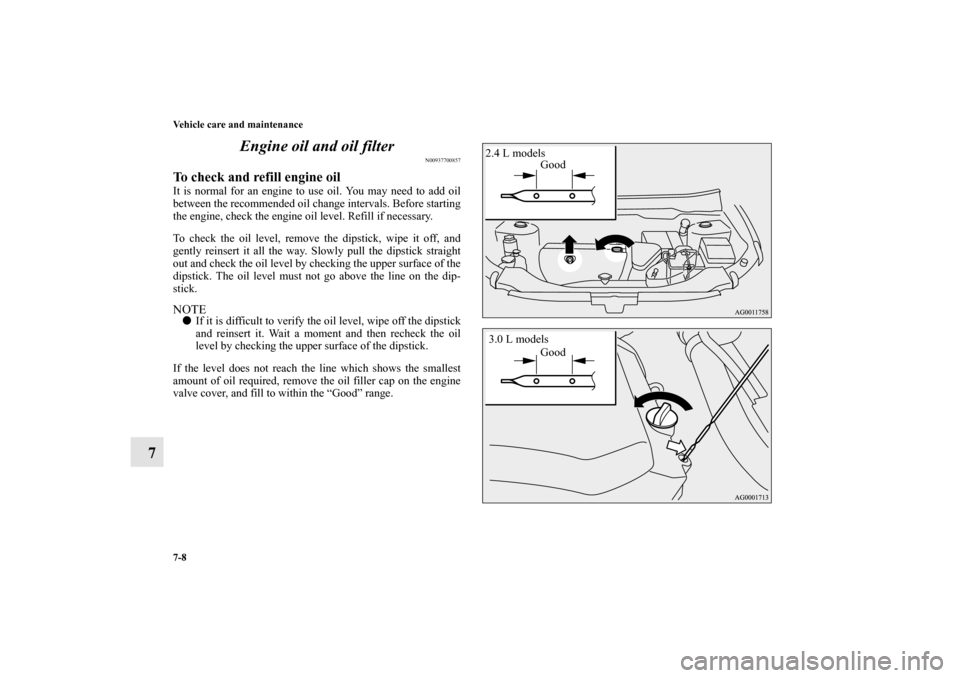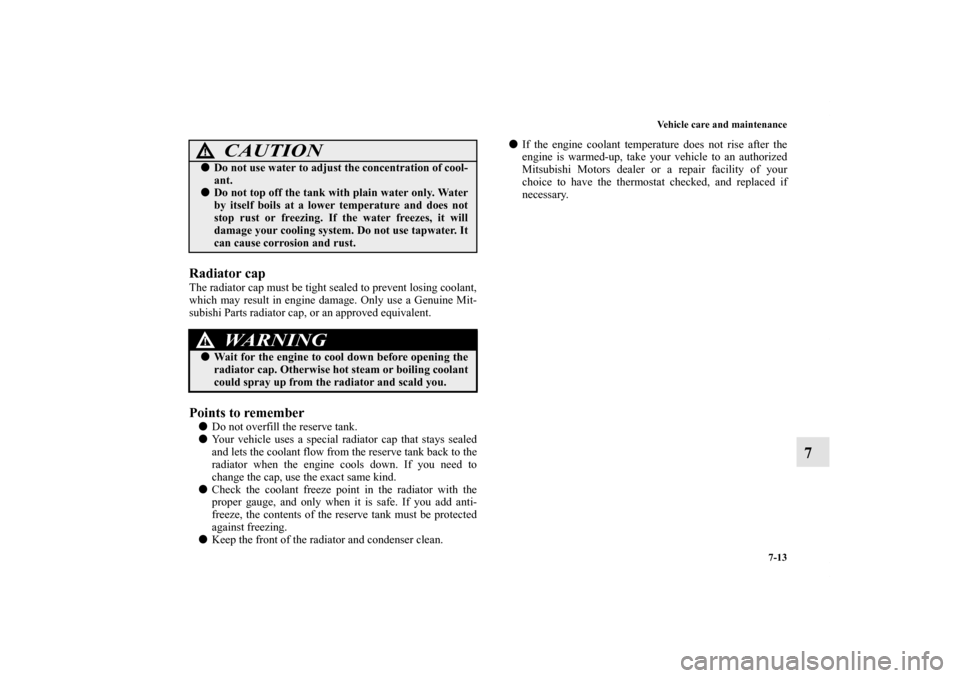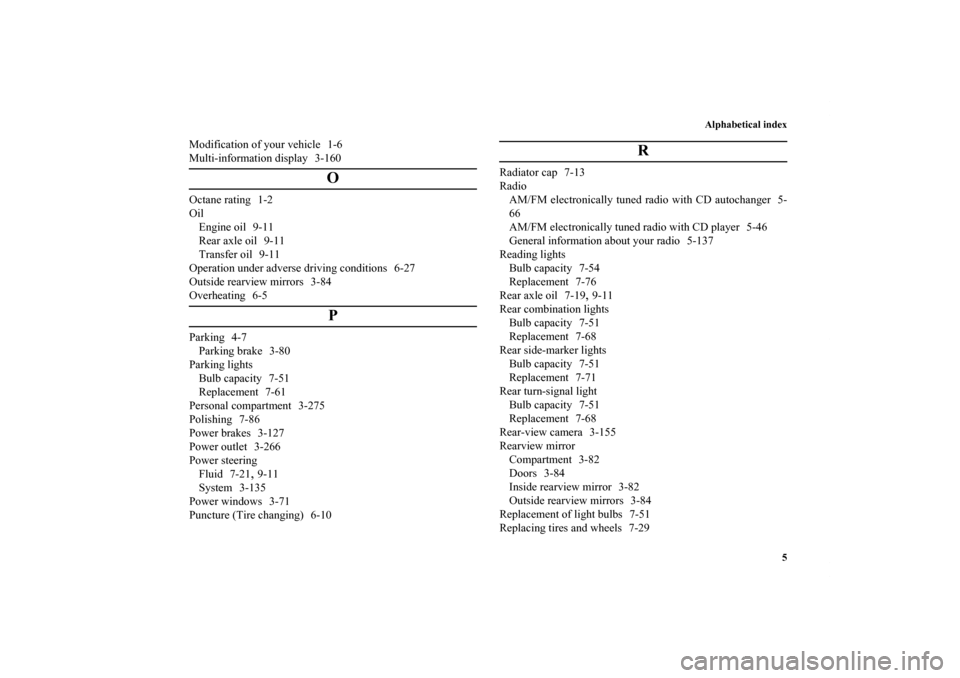Page 239 of 714

3-124 Features and controls
3
Driving through water
N00537800085
If the electrical circuits become wet, further operation of the
vehicle will be impossible; therefore, avoid driving through
water unless absolutely necessary. If driving through water is
unavoidable, use the following procedure:
Check the depth of the water and the terrain before attempting
to drive through it. Drive slowly to avoid creating excessive
water splashing.
Inspection and maintenance following
rough road operation
N00530700085
After operating the vehicle in rough road conditions, be sure to
perform the following inspection and maintenance procedures:
�Check that the vehicle has not been damaged by rocks,
gravel, etc.
�Carefully wash the vehicle with water.
Drive the vehicle slowly while lightly depressing the
brake pedal in order to dry out the brakes. If the brakes
still do not function properly, contact an authorized Mit-
subishi Motors dealer or a repair facility of your choice as
soon as possible to have the brakes checked.
�Remove the insects, dried grass, etc. clogging the radiator
core.
�After driving through water, check the engine, transaxle
and differential oil. If the oil or grease is milky or cloudy
because of water contamination, it must be replaced with
new oil.
�Check the inside of the vehicle. If water entry is found,
dry the carpet etc.
�Inspect the headlights. If water is in the headlight housing,
have it drained at an authorized Mitsubishi Motors dealer
or a repair facility of your choice.
CAUTION
!�Never drive through water that is deep enough to
cover wheel hubs, axles or exhaust pipe. Do not
change the selector lever position while driving
through water.
Frequent driving through water can adversely affect
the life span of the vehicle; consult an authorized
Mitsubishi Motors dealer or a repair facility of your
choice and take the necessary measures to prepare,
inspect, and repair the vehicle.�After driving through water, apply the brakes to be
sure they are functioning properly. If the brakes are
wet and not functioning properly, dry them out by
driving slowly while lightly depressing the brake
pedal. Inspect each part of the vehicle carefully.
BK0122500US.book 124 ページ 2010年5月12日 水曜日 午前11時11分
Page 589 of 714
6-20 For emergencies
6
[Vehicle with aluminum wheels]
• Normal wheels
Temporarily tighten the wheel nuts (flange nuts) until
their flange section comes in contact with the wheel and
it is no longer loose.• Compact spare wheel
Install the wheel nuts with their tapered ends facing
inward, then tighten by hand until the wheel is no longer
loose.
NOTE�Flange nuts can be temporarily used on the compact spare
or steel wheel, but return them to the original wheel and
tire as soon as possible.
�If all 4 wheels are changed to steel wheels, use tapered
nuts.
CAUTION
!�Never apply oil to either the wheel bolts or the nuts
or they will tighten too much.
BK0122500US.book 20 ページ 2010年5月12日 水曜日 午前11時11分
Page 605 of 714

7-8 Vehicle care and maintenance
7Engine oil and oil filter
N00937700857
To check and refill engine oilIt is normal for an engine to use oil. You may need to add oil
between the recommended oil change intervals. Before starting
the engine, check the engine oil level. Refill if necessary.
To check the oil level, remove the dipstick, wipe it off, and
gently reinsert it all the way. Slowly pull the dipstick straight
out and check the oil level by checking the upper surface of the
dipstick. The oil level must not go above the line on the dip-
stick.NOTE�If it is difficult to verify the oil level, wipe off the dipstick
and reinsert it. Wait a moment and then recheck the oil
level by checking the upper surface of the dipstick.
If the level does not reach the line which shows the smallest
amount of oil required, remove the oil filler cap on the engine
valve cover, and fill to within the “Good” range.
2.4 L models
Good
Good 3.0 L models
BK0122500US.book 8 ページ 2010年5月12日 水曜日 午前11時11分
Page 610 of 714

Vehicle care and maintenance
7-13
7
Radiator capThe radiator cap must be tight sealed to prevent losing coolant,
which may result in engine damage. Only use a Genuine Mit-
subishi Parts radiator cap, or an approved equivalent.Points to remember�Do not overfill the reserve tank.
�Your vehicle uses a special radiator cap that stays sealed
and lets the coolant flow from the reserve tank back to the
radiator when the engine cools down. If you need to
change the cap, use the exact same kind.
�Check the coolant freeze point in the radiator with the
proper gauge, and only when it is safe. If you add anti-
freeze, the contents of the reserve tank must be protected
against freezing.
�Keep the front of the radiator and condenser clean.�If the engine coolant temperature does not rise after the
engine is warmed-up, take your vehicle to an authorized
Mitsubishi Motors dealer or a repair facility of your
choice to have the thermostat checked, and replaced if
necessary.�Do not use water to adjust the concentration of cool-
ant.�Do not top off the tank with plain water only. Water
by itself boils at a lower temperature and does not
stop rust or freezing. If the water freezes, it will
damage your cooling system. Do not use tapwater. It
can cause corrosion and rust.
WA R N I N G
!�Wait for the engine to cool down before opening the
radiator cap. Otherwise hot steam or boiling coolant
could spray up from the radiator and scald you.
CAUTION
!
BK0122500US.book 13 ページ 2010年5月12日 水曜日 午前11時11分
Page 615 of 714
7-18 Vehicle care and maintenance
7Continuously variable transmission (CVT)
fluid
(if so equipped)
N00938100021
The continuously variable transmission (CVT) should be main-
tained and serviced by an authorized Mitsubishi Motors dealer
or a repair facility of your choice to obtain the best perfor-
mance and longest life. It is important that the transmission
fluid is kept at the correct level.Fluid typeUse only “DiaQueen CVTF-J1” transmission fluid to ensure
optimum transmission performance.Special additivesDo not use any fluid additives to the transmission.
Transfer oil (All-wheel drive models)
N00938400226
Whenever the transfer oil level is checked, add oil as necessary
to maintain the proper level. Fill or change the oil according to
the table.Fluid type
Lubricant Hypoid gear oil API classification GL-5
Viscosity range SAE 80
BK0122500US.book 18 ページ 2010年5月12日 水曜日 午前11時11分
Page 616 of 714
Vehicle care and maintenance
7-19
7 Rear axle oil (All-wheel drive models)
N00915200197
Whenever the oil level is checked, add oil as necessary to
maintain the proper level.
Fill or change oil according to the table.Fluid type
Wa s h e r f l u i d
N00938600228
The windshield and rear window washer fluid reservoir is in
the engine compartment.
Check the washer fluid level at regular intervals and add
washer fluid to reservoir if necessary.
Open the reservoir cap and check the fluid level with the dip-
stick.
When freezing weather is anticipated, flush out the water in the
reservoir by operating the pump. Fill the reservoir with wind-
shield antifreeze (not radiator antifreeze), and operate the sys-
tem for a few seconds to flush out the residual water.
Lubricant Hypoid gear oil API classification GL-5
Viscosity range SAE 80
FULLEMPTY
BK0122500US.book 19 ページ 2010年5月12日 水曜日 午前11時11分
Page 637 of 714

7-40 Vehicle care and maintenance
7
Drive belt for generator and air conditioning compres-
sorCheck the tension of the drive belt. Make certain that the indi-
cator (A) is between the specified lines as shown in the illustra-
tion.
Check the drive belt for cuts and cracks, and replace it if it is
damaged. When replacing the belt, make sure that there is no
interference between the belt and other engine components.
After replacing, recheck the tension to make sure the indicator
(A) is between the specified lines.
Exhaust system
N00942200094
The best way to keep carbon monoxide gas from entering
inside your vehicle is to have the engine exhaust system prop-
erly serviced.
Have a competent mechanic inspect the complete exhaust sys-
tem and nearby body areas for broken, damaged, deteriorated,
or mispositioned parts if you notice any of the following:
�A change in the sound of the exhaust system
�The smell of exhaust fumes inside the vehicle
�The underside or rear of the vehicle is damaged
Also check the exhaust system each time the vehicle is raised
for lubrication, oil changes, or required service. Any open
seams or loose connections could let dangerous exhaust fumes
seep into the luggage compartment and passenger compart-
ments.Check for any of the following conditions:�Check for holes or exhaust gas leaks caused by corrosion
or damage.
�Check the joints and connections for looseness or exhaust
gas leaks.
�Check the rubber hangers and brackets for damage.
WA R N I N G
!�Do not check or touch the drive belt with the engine
running, or serious injury or death may result.
WA R N I N G
!�Carbon monoxide gas from your vehicle’s exhaust is
poisonous. Breathing these fumes can cause uncon-
sciousness or death.
BK0122500US.book 40 ページ 2010年5月12日 水曜日 午前11時11分
Page 708 of 714

Alphabetical index
5
Modification of your vehicle 1-6
Multi-information display 3-160
O
Octane rating 1-2
Oil
Engine oil 9-11
Rear axle oil 9-11
Transfer oil 9-11
Operation under adverse driving conditions 6-27
Outside rearview mirrors 3-84
Overheating 6-5
P
Parking 4-7
Parking brake 3-80
Parking lights
Bulb capacity 7-51
Replacement 7-61
Personal compartment 3-275
Polishing 7-86
Power brakes 3-127
Power outlet 3-266
Power steering
Fluid 7-21
,9-11
System 3-135
Power windows 3-71
Puncture (Tire changing) 6-10
R
Radiator cap 7-13
Radio
AM/FM electronically tuned radio with CD autochanger 5-
66
AM/FM electronically tuned radio with CD player 5-46
General information about your radio 5-137
Reading lights
Bulb capacity 7-54
Replacement 7-76
Rear axle oil 7-19
,9-11
Rear combination lights
Bulb capacity 7-51
Replacement 7-68
Rear side-marker lights
Bulb capacity 7-51
Replacement 7-71
Rear turn-signal light
Bulb capacity 7-51
Replacement 7-68
Rear-view camera 3-155
Rearview mirror
Compartment 3-82
Doors 3-84
Inside rearview mirror 3-82
Outside rearview mirrors 3-84
Replacement of light bulbs 7-51
Replacing tires and wheels 7-29
BK0122500US.book 5 ページ 2010年5月12日 水曜日 午前11時11分